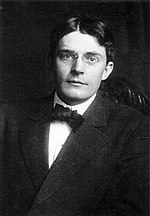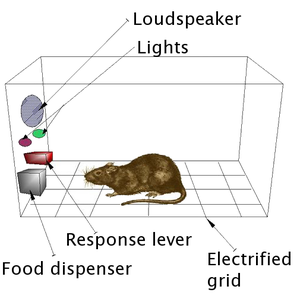Introduction to Psychology 1/IPSY101/History/Behaviourism
| “ | A failure is not always a mistake, it may simply be the best one can do under the circumstances. The real mistake is to stop trying. | ” |
| —B.F. Skinner | ||
John B. Watson (1878–1958) was an influential American psychologist whose most famous work occurred during the early 20th century at Johns Hopkins University. While Wundt and James were concerned with understanding conscious experience, Watson thought that the study of consciousness was flawed. Because he believed that objective analysis of the mind was impossible, Watson preferred to focus directly on observable behaviour and try to bring that behaviour under control. Watson was a major proponent of shifting the focus of psychology from the mind to behaviour, and this approach of observing and controlling behaviour came to be known as behaviourism. A major object of study by behaviourists was learned behaviour and its interaction with inborn qualities of the organism. Behaviourism commonly used animals in experiments under the assumption that what was learned using animal models could, to some degree, be applied to human behaviour. Indeed, Tolman (1938[1]) stated, “I believe that everything important in psychology (except … such matters as involve society and words) can be investigated in essence through the continued experimental and theoretical analysis of the determiners of rat behaviour at a choice-point in a maze.”
Behaviourism dominated experimental psychology for several decades, and its influence can still be felt today (Thorne & Henley, 2005[2]). Behaviourism is largely responsible for establishing psychology as a scientific discipline through its objective methods and especially experimentation. In addition, it is used in behavioural and cognitive-behavioural therapy. Behaviour modification is commonly used in classroom settings. Behaviourism has also led to research on environmental influences on human behaviour.
Skinner box
B. F. Skinner (1904–1990) was an American psychologist. Like Watson, Skinner was a behaviourist, and he concentrated on how behaviour was affected by its consequences. Therefore, Skinner spoke of reinforcement and punishment as major factors in driving behaviour.
As a part of his research, Skinner developed a chamber that allowed the careful study of the principles of modifying behaviour through reinforcement and punishment. This device, known as an operant conditioning chamber (or more familiarly, a Skinner box), has remained a crucial resource for researchers studying behaviour (Thorne & Henley, 2005).
The Skinner box is a chamber that isolates the subject from the external environment and has a behaviour indicator such as a lever or a button. When the animal pushes the button or lever, the box is able to deliver a positive reinforcement of the behaviour (such as food) or a punishment (such as a noise) or a token conditioner (such as a light) that is correlated with either the positive reinforcement or punishment.
Skinner’s focus on positive and negative reinforcement of learned behaviours had a lasting influence in psychology that has waned somewhat since the growth of research in cognitive psychology. Despite this, conditioned learning is still used in human behavioural modification. Skinner’s two widely read and controversial popular science books about the value of operant conditioning for creating happier lives remain as thought-provoking arguments for his approach (Greengrass, 2004[3]).
References
- ↑ Tolman, E. C. (1938). The determiners of behaviour at a choice point. Psychological Review, 45, 1–41.
- ↑ Thorne, B. M., & Henley, T. B. (2005). Connections in the history and systems of psychology (3rd ed.). Boston, MA: Houghton Mifflin Company.
- ↑ Greengrass, M. (2004). 100 years of B.F. Skinner. Monitor on Psychology, 35, 80.
- Source
- This page was proudly adapted from Psychology published by OpenStax CNX. Oct 31, 2016 under a Creative Commons Attribution 4.0 license. Download for free at http://cnx.org/contents/4abf04bf-93a0-45c3-9cbc-2cefd46e68cc@5.52.




